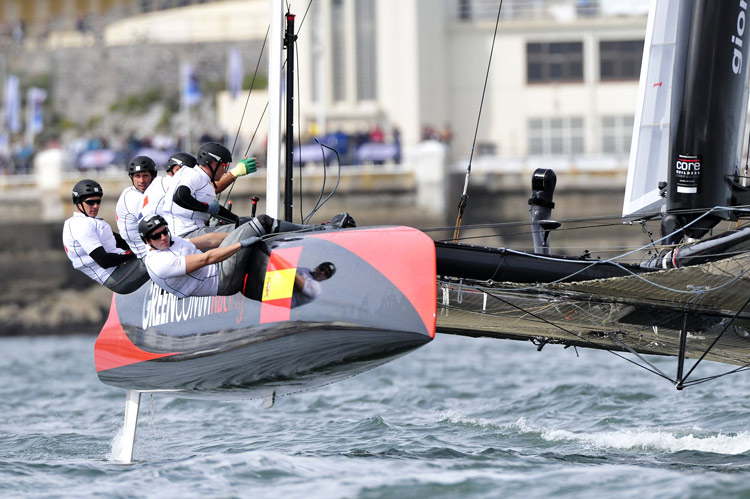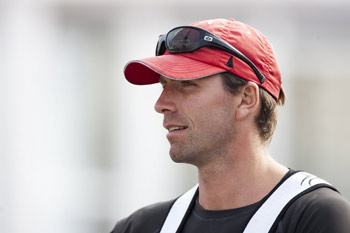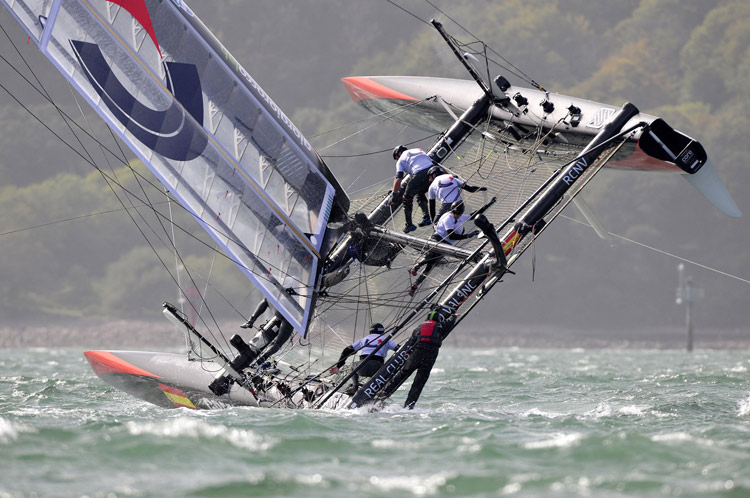
GreenComm crew hangs out together. Photo:©2011 ACEA/Pierrick
Contin
|
|
 |
|
|
Ed Wright.
Photo:©2011 ACEA/Gilles Martin-Raget
|
Bursting onto the British sailing scene in
2006 with a Gold Medal performance at the Finn Europeans, Ed
Wright had to think the coast was clear for a slot on the
British Olympic team heading into the 2008 games in Beijing.
After all, Athens Gold medalist Ben Ainslie was busy driving
the Emirates Team New Zealand trial horse in preparation for
the 2007 America’s Cup.
Not so fast. Ainslie returned to the Finn class after
the 2007 America’s Cup Match and took the sole British Finn
spot away from Wright. But along the road to the
London Olympics in 2012, the 2010 Finn World Champion
decided to take out something of an insurance policy, should
he not be named to next year’s Olympic team -- Wright signed
with GreenComm Racing as tactician. And as it turns
out, last month Ainslie was named as the Finn representative
in London in 2012, leaving Wright as the beneficiary of a
very good career move.
Wright has not abandoned the Finn entirely, as he will be
joining Ainslie and three other British Finn sailors at the
ISAF Sailing World Championships in Perth come December, but
for this week he sails under the Spanish flag of the
GreenComm effort. Given the intense winds during the
recent America’s Cup World Series event in Plymouth,
England, and the fickle conditions thus far in San Diego,
it’s no surprise that he terms the AC45 “perfect
conditioning for the Finn.” He also appreciates the
opportunity the AC45 has turned out to be for younger
multihull sailors.
“It is quite an opportunity for a lot more youth in the
America’s Cup,” said Wright. “The guys have to be
strong and it’s really a nice thing to see, all this energy.
The racing is fast and furious, and it’s so much fun for us
on the boats! It’s not a situation where you’re on one tack
for a long time, just slowly edging out the next boat.
You’re really involved as the decisions are made -- very
quick decisions! You can receive results instantly, so it’s
great coming from Olympic sailing, where it’s like that all
the time.”
Like Ainslie, Wright has had to get used to being part of a
team. While the extensive British sailing program
ensures that no one is alone for very long, the racing
aspect in that situation is a solitary experience.
Though the AC45 does not have the large complement of
sailors the old America’s Cup Class Version 5 had, it has a
bit of a learning curve even when it comes to a small crew
sailing as one whole.
“The whole Olympic sailing concept is working as a team, to
make you perform the best you can. But I do have to
understand the communication, and we’re still working on
that. It’s quite difficult on our boat communication
is half Spanish and half English! Working as a team is very
important for us to go forward. It’s different, but
it’s enjoyable having someone there all the time to tag you
out or to help you if you’re getting tired.”
Wright was originally listed as tactician, but now shares
the more egalitarian “sailing team member” title, as do all
the rest of the sailors. He acknowledges that they are
all still figuring things out.
“I suppose ‘floater and bowman’ is my job description, but
we’re all really multitasking and freestyling. We’ve
been doing a lot of crew changing in this regatta, bringing
in a whole bunch of guys who haven’t been on the boat.
We’re all relearning the process -- just replacing one guy
makes such a big difference so we’re taking it step by
step.”
GreenComm took a hit literally and
figuratively at the previous America’s Cup World Series
event in Plymouth, in a collision with Artemis Racing that
damaged the port ama. The team was only able to work
on the boat for a short time before having to put it in the
container and onto a ship headed for San Diego, so GreenComm
lost time the first week after arrival in San Diego as boat
repairs continued. Time in the shed is time on the
water lost.
“Luckily the major event wasn’t until this weekend, so we
have time to train. Last week was pretty much about
fixing the boat.
“On these boats, it’s pure multitasking. You have to
be able to pick up one second and put it down the next
second, do it very quickly, and have your head both inside
and outside the boat. So it’s very physical and you
have to be very aware. I admire the guys at the top at
the moment, it’s just incredible how they’ve been able to
test everything so quickly and we’re still learning how to
get these techniques down. Hopefully it will come!
“


